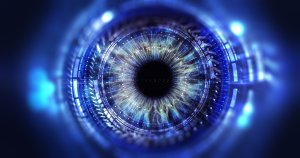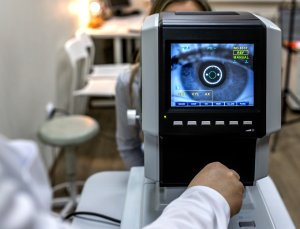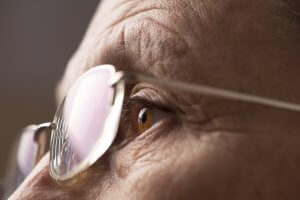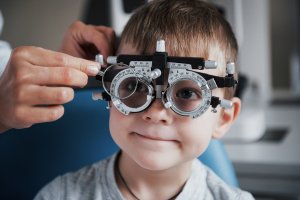“I highly endorse this facility and these doctors.”
— Actual patient review posted on HealthGrades.com
Count on the retinal eye care experts at Eye Consultants of Pennsylvania
Every year, more than 34 million American adults suffer from a variety of retinal diseases such as diabetic retinopathy, floaters, retinal detachment and macular degeneration. Retinal eye diseases have many of the same symptoms, the most common of which is blurred vision, and can have a significant impact on your overall quality of life if not detected and treated as soon as possible. Talk with one of our retinal eye specialists about the risk factors, the importance of early detection and the treatment options available. And a dilated retinal eye exam by an Eye Consultants of Pennsylvania retina specialist is a good first step.
When it comes to retinal conditions and diseases, insist on the experts
Each of our retinal specialists is Board-Certified and Fellowship-Trained. That’s quality and experience you can trust. They utilize the latest technology and enjoy an excellent reputation and high patient satisfaction. From the first moment a friendly staff member greets you, throughout your treatment, you’ll receive the compassionate care and personal attention that you deserve.
Diabetic Eye Care, Macular Degeneration, Retinal Eye Care
Board-Certified, Fellowship-Trained
Wyomissing, Pottsville, Lebanon
Diabetic Eye Care, Macular Degeneration, Retinal Eye Care
Board-Certified, Fellowship-Trained
Wyomissing, Pottstown, Pottsville
Diabetic Eye Care, Macular Degeneration, Retinal Eye Care
Board-Certified, Fellowship-Trained
Wyomissing, Pottstown, Pottsville
What is Diabetic Retinopathy?
Diabetic retinopathy is the most common diabetic eye disease and a leading cause of blindness in American adults. It is caused by damage to the blood vessels in the retina, which is the light-sensitive tissue that lines the inside of the eye and allows you to see fine detail.
There are generally two types of diabetic retinopathy. Nonproliferative and proliferative. Nonproliferative diabetic retinopathy occurs when the blood vessels in a person’s retina weaken and tiny bulges protrude from their walls, sometimes leaking fluid and blood into the retina. Proliferative diabetic retinopathy is the most severe type of diabetic retinopathy and occurs when there is growth of abnormal blood vessels. This may lead to bleeding or scar tissue formation, which can cause the retina to detach and result in permanent vision loss.
Anyone who has diabetes can develop diabetic retinopathy. The risk is increased the longer you have diabetes and the less controlled your blood sugars are. Additionally, high blood pressure, high cholesterol, pregnancy, and smoking can play a role in disease progression. Although the very early stages may be asymptomatic with minimal affect on vision, it is extremely important to be checked regularly with a complete eye exam to prevent complications which could lead to blindness.
If mild nonproliferative diabetic retinopathy is present, treatment of the eye may not be necessary if blood sugar is well maintained. If you develop more advanced nonproliferative or proliferative diabetic retinopathy, treatment options include laser, surgery, and/or injectable medications.
The diabetic eye care specialists at Eye Consultants of Pennsylvania are Board-Certified and Fellowship-trained. They utilize the most advanced diagnostic and treatment technologies and are very experienced with the latest treatment techniques.
What are the symptoms of diabetic retinopathy?
Because diabetic retinopathy often lacks early symptoms, people with diabetes should get a comprehensive dilated eye exam at least once a year. People with diabetic retinopathy may need eye exams more frequently. Women with diabetes who become pregnant should have a comprehensive dilated eye exam as soon as possible. Additional exams during pregnancy may be needed.
Studies such as the Diabetes Control and Complications Trial (DCCT) have shown that controlling diabetes slows the onset and worsening of diabetic retinopathy. DCCT study participants who kept their blood glucose level as close to normal as possible were significantly less likely than those without optimal glucose control to develop diabetic retinopathy, as well as kidney and nerve diseases. Other trials have shown that controlling elevated blood pressure and cholesterol can reduce the risk of vision loss among people with diabetes.
Bottom line: early detection and treatment is the best way to limit the negative effects of diabetic eye disease. If you have diabetes in any form, schedule a comprehensive eye exam with an experienced diabetic eye disease specialist at least once each year.
What are the treatment options for diabetic retinopathy?
Treatment options depend upon the nature of the diabetic eye disease but can include options from medications to laser surgery. Based on your vision diagnosis during examination, our diabetic eye care specialists will discuss with you the most appropriate treatment options.
What is Macular Degeneration?
Macular degeneration, or age-related macular degeneration (AMD) is a leading cause of vision loss in Americans 60 and older. It is a disease that destroys your sharp, central vision. You need central vision to see objects clearly and to do tasks such as reading and driving.
AMD affects the macula, the part of the eye that allows you to see fine detail. It does not hurt, but it causes cells in the macula to die. In some cases, AMD advances so slowly that people notice little change in their vision. In others, the disease progresses faster and may lead to a loss of vision in both eyes.
There are two forms of age-related macular degeneration -- dry and wet.
Dry AMD: Dry AMD occurs when the light-sensitive cells in the macula slowly break down, gradually blurring central vision in the affected eye. As dry AMD gets worse, you may see a blurred spot in the center of your vision. Over time, as less of the macula functions, central vision in the affected eye can be lost gradually.
Wet AMD: Wet AMD occurs when abnormal blood vessels behind the retina start to grow under the macula. These new blood vessels tend to be very fragile and often leak blood and fluid. The blood and fluid raise the macula from its normal place at the back of the eye
Regular comprehensive eye exams can detect macular degeneration before the disease causes vision loss. Treatment can slow vision loss. It does not restore vision. That’s why early diagnosis and treatment are always the best options
The macular degeneration specialists at Eye Consultants of Pennsylvania are Board-Certified and Fellowship-trained. They utilize the most advanced diagnostic and treatment technologies and are very experienced with the latest treatment techniques.
What are the symptoms of AMD?
AMD causes no pain. In some cases, AMD advances so slowly that people notice little change in their vision. In others, the disease progresses faster and may lead to a loss of vision in both eyes. The most common symptom of dry AMD is slightly blurred vision. You may have difficulty recognizing faces. You may need more light for reading and other tasks. Dry AMD generally affects both eyes, but vision can be lost in one eye while the other eye seems unaffected.
Another of the most common early signs of dry AMD is drusen. Drusen are yellow deposits under the retina. They often are found in people over age 60. Some people see a blurred spot in the center of their vision. More light may be needed for reading and other tasks. More advanced dry AMD can cause a blurred spot in the center of your vision. Over time, the blurred spot may get bigger and darker, taking more of your central vision. You may have difficulty reading or recognizing faces until they are very close to you
An early symptom of wet AMD is that straight lines appear wavy. If you notice this condition or other changes to your vision, contact your eye care professional at once. You need a comprehensive dilated eye exam. With wet AMD, loss of central vision can occur quickly. Wet AMD is considered to be advanced AMD and is more severe than the dry form.
With either wet or dry AMD, vision lost cannot be restored. That’s why early detection and treatment is the best way to limit the negative effects of macular degeneration. Schedule a comprehensive eye exam with an experienced retinal disease specialist at least once each year.
What are the treatment options for AMD?
Once Dry AMD reaches the advanced stage, no form of treatment can prevent vision loss. However, treatment can delay and possibly prevent intermediate AMD from progressing to the advanced stage. The National Eye Institute's Age-Related Eye Disease Study found that taking certain vitamins and minerals may reduce the risk of developing advanced AMD.
Wet AMD can be treated with laser surgery, photodynamic therapy, and injections into the eye. None of these treatments is a cure for wet AMD. The disease and loss of vision may progress despite treatment.
What is Retinal Detachment?
Retinal detachment is an eye problem that happens when your retina (a light-sensitive layer of tissue in the back of your eye) is pulled away from its normal position at the back of your eye.
What are the symptoms of retinal detachment?
If only a small part of your retina has detached, you may not have any symptoms. But if more of your retina is detached, you may not be able to see as clearly as normal, and you may notice other sudden symptoms, including:
- A lot of new gray or black specks floating in your field of vision (floaters)
- Flashes of light in one eye or both eyes
- A dark shadow or “curtain” on the sides or in the middle of your field of vision
Important: Retinal detachment can be a medical emergency.
If you have symptoms of a detached retina, it’s important to go to your eye doctor or the emergency room right away.
The symptoms of retinal detachment often come on quickly. If the retinal detachment isn’t treated right away, more of the retina can detach — which increases the risk of permanent vision loss or blindness.
What are the treatment options for retinal detachment?
Depending on how much of your retina is detached and what type of retinal detachment you have, your eye doctor may recommend laser surgery, freezing treatment, or other types of surgery to fix any tears or breaks in your retina and reattach your retina to the back of your eye. Sometimes, your eye doctor will use more than one of these treatments at the same time.
Freeze treatment (cryopexy) or laser surgery – If you have a small hole or tear in your retina, your doctor can use a freezing probe or a medical laser to seal any tears or breaks in your retina. You can usually get these treatments in the eye doctor’s office.
Surgery – If a larger part of your retina is detached from the back of your eye, you may need surgery to move your retina back into place. You will probably get these surgeries in a hospital.
Treatment for retinal detachment works well, especially if the detachment is caught early. In some cases, you may need a second treatment or surgery if your retina detaches again — but treatment is ultimately successful for about 9 out of 10 people.
Learn more about retinal conditions and diseases diagnosis and treatment.
“Excellent Physician. Great patient care, high medical skills with compassion for the patients, communicates well with the patients and really cares about them.”
What do our patients say?
See what our patients say about the doctors at Eye Consultants of Pennsylvania.
Take the first step.
A a careful, dilated eye examination by one of our retinal specialists is the first step. Our doctors use very specialized technologies — and years of training and experience — to examine your eyes and check for the presence of disease. At your examination, your doctor will personally discuss with you the health of your eyes, how your condition is affecting your vision and what treatment options are available. The bottom line: trust the experts. Insist on Eye Consultants of Pennsylvania.
Does my insurance plan
cover my eye care?
Find out what insurance we accept and what is covered by insurance.
Learn more about
retinal eye care
We’re committed to patient education. Get more information about retinal eye care, including diagnoses and treatment options.
Schedule an Appointment
Schedule an appointment with one of our specialists.





